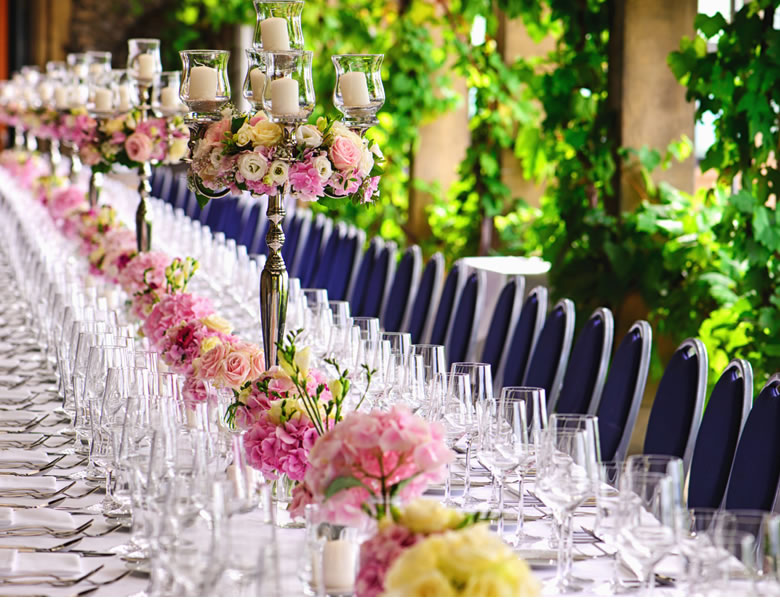Centerpieces 101 – The Importance of a Centerpiece
Whether you’re attending a wedding, fundraising dinner, or professional conference, you are sure to be seated at a banquet table. In the middle of the table is a centerpiece. Some centerpieces are simple and others are elaborate, but whatever is found at the center of the table is meant to draw attention and make a statement. It’s undeniable: centerpieces are important.
Why Consider a Floral Centerpiece?
There are so many options to consider when selecting a centerpiece for your special event. Many people decide to use photographs, floating candles, jars of sand and seashells, stacks of vintage books…the list goes on and on. The need to be creative and unique has grown in importance in recent years.
But there is something classic and timeless about a floral centerpiece. The possibilities are endless. Arrangements vary from traditional to modern and everything in between. Given the variety of species, colors, and sizes of flowers, a floral centerpiece can be as unique as you are.
There is one thing that puts a floral centerpiece head and shoulders above any of the other non-traditional options: the opportunity to collaborate with an expert. Florists are artists. They take your event and dissect it, ask you questions, then create a piece that reflects the nature of your event. You walk away with a unique, meaningful, and beautiful centerpiece that represents the true purpose of your momentous occasion. Two heads are indeed better than one.
Once again, the principles of floral design are numerous. Each florist incorporates both common and individual principles to create a centerpiece. Today we will be focusing on 6 commonly accepted principles of centerpiece arrangements:
Design
This refers to the size and shape of the arrangement and is determined based on the occasion, event location, and materials.
Balance
This is determined by the form and color of the arrangement:
Symmetrical Balance: Each side of the arrangement has an equal amount of materials.
Asymmetrical Balance: The sides do not contain equal amounts, but do have equal amounts of visual interest. Visual interest is strongly influenced by the use of color. Dark colors are “heavy” and usually used in the lower portion of the arrangement, while lighter colors are best used in the outer and upper portions. The use of contrast creates visual interest in the piece.
Scale
This refers to the proportion of materials used relative to the container. It is also defined by the size and shape of the flowers used. Traditionally, smaller flowers are used at the top and center of the piece, with the full blossoms placed at the bottom and center and partially opened blooms are used to fill the “in-between” portion of the arrangement.
Rhythm
This plays an important role in directing the individual’s attention to the arrangement’s “main line” and allows the viewer to understand the piece as their eyes wander along the main line.
Emphasis
The focal point of the arrangement is the central point from which all other components appear to originate. Although considered the central point, focal point is not necessarily located at the center of the arrangement. The focal point is often a large or unusual flower or cluster that stands out. Emphasis is created by using a variety of flowers and other materials so that attention is drawn to the focal point.
Harmony & Unity
This refers to the blending of colors, repetition, and use of an appropriate container to display the arrangement. Harmony and unity are created when the arrangement is proportional to both the container used and the event venue.
Floral Centerpiece:
Styles
There are many different ways of classifying a floral centerpiece. Today we will be focusing on 3 general styles:
Oriental
Oriental arrangements emphasize the lines of the arrangement. The principle of rhythm is of great significance when designing an oriental arrangement. In addition, the use of asymmetrical balance is what frequently creates the focal point of the piece.
Traditional/Western
Traditional arrangements emphasize the use of many flowers in the mass of the arrangement. These pieces are often symmetrical in balance and are very particular about the proper use of scale in their design.
Modern
Modern arrangements emphasize your unique needs, desires, and vision. Because of this, the principles of design can vary greatly in importance. Clients often select an asymmetrical balance to draw attention to the piece. Unique flowers are used to define the focal point rather than opting for a cluster of blooms. Another characteristic of modern arrangements includes drastic variations in flower size. A key aspect of modern arrangements tends to be an intense focus on the exaggeration of one floral design principle to make a statement.
Floral Centerpieces: The Bottom Line
As you can see, there are many things to consider when designing a centerpiece. Several of these concepts come naturally to most people. We know that the arrangement has a focal point that it is often created using size and color. We know that the different parts of the arrangement should fit together as a whole. We know a successful centerpiece when we see one.
But it takes a trained decorator to take your event, apply these principles, and create a centerpiece that defines your vision. This creative ability is what allows the professionals at Inner Circle Décor turn centerpieces into works of art.
Are you planning an event? Are you in need of the perfect centerpiece? Do you have a distinct desire to capture the attention of your guests with something unique? Consider the countless available and affordable options provided by Inner Circle Décor


 REQUEST A QUOTE
REQUEST A QUOTE